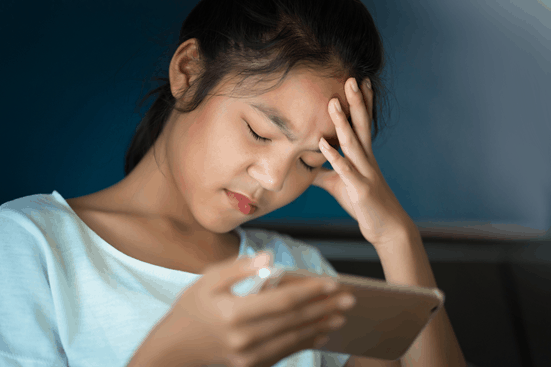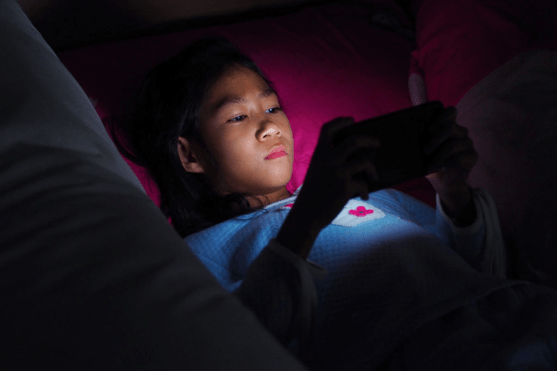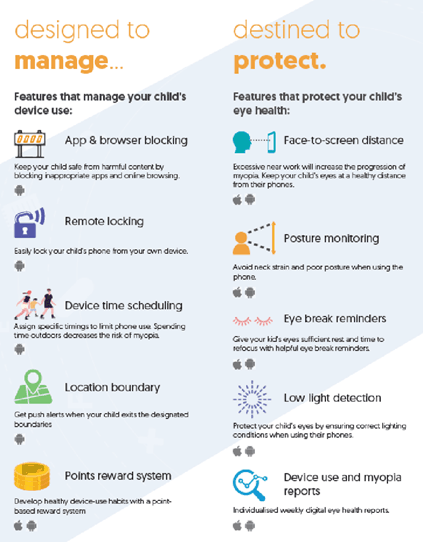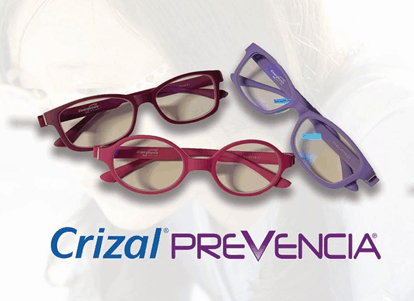3 Ways Eye Strain is Taking a Toll on your Kids and What You Can Do About it
Submitted by Advertiser KiasuParent
As your kids spend more time on their phones these days, you may start noticing more complaints of ‘itchy’ eyes and headaches. They may be victims of digital eye strain, one of the many consequences of their unhealthy tech habits.
Eye strain is particularly tough on our children’s still-developing eyes. On top of headaches and eye irritation, it may cause other symptoms including – pain, dryness, burning, redness, sensitivity to light and a loss of the eye’s ability to focus correctly, resulting in blurred vision.

Eye strain is very common, and you may have already seen its effects in your own children – they may complain of dryness and you may have seen them incessantly rubbing their eyes, and by the time you’ve caught them in the act, their eyes have turned an alarming shade of pink.
It is very likely that those bright, flickering smart device screens that are often held for far too long and too close to our children’s delicate eyes are to blame for their suffering.
The good news is, there are simple solutions to your problems. Digital eye strain can be avoided with some simple behavioural changes. As is often the case, education is the first step. In order to know how to help your children to avoid digital eye strain, it will help you to first understand what causes digital eye strain, what it looks like, and what can be done to stop it.
Here are some of the common risk factors of eye strain and associated health symptoms and how to address them once and for all.
1. Excessive screen time
If left unsupervised, our children could go hours hunched over their mobile devices, scrolling through their endless feeds without any breaks. Why exactly is this bad for their eyes?
Research shows that three hours or longer of screen time per day is linked to an increase in the likelihood of developing dry eye in children, one of the symptoms of eye strain, by more than 13 times! Reasons for this are complex but include reduced and incomplete blinking while staring at screens.
The fix: Taking regular breaks in between periods of screen exposure is crucial. The American Optometric Association recommends taking a 15-minute break after 2 hours of device use.
A helpful way for your children to remember this is by observing the 20-20-20 strategy (looking at objects 20 feet away for 20 seconds after 20 minutes of screen time).
2. Prolonged blue light exposure
Our children’s increased exposure to blue light from their screens also causes eye strain. How exactly does this happen? When blue light enters their eyes, it scatters and increases the effort needed by their eyes to maintain focus. This increased effort may contribute to eye fatigue and eventually eye strain.

The implications of blue light don’t just stop at digital eye strain. As it turns out, blue light also impacts the quality of sleep. Blue light suppresses the production of melatonin, a hormone produced by the brain that helps induce sleep. Think about all the times your child has woken up tired and temperamental. His/her routine of using the phone before bedtime could have been to blame for causing a poor night’s sleep and the eventual grogginess the following day!
Worse yet, research suggests that the lack of quality sleep causes your child’s blink rate to slow. This decreases tear production and increases tear evaporation – leading to dry eye and more eye strain!
The fix: It takes about 2 hours for blue light exposure to suppress melatonin production. As such, a digital curfew on all electronics 1 – 2 hours before bedtime effectively allows the body’s natural production of melatonin to kick in. You can also dim the brightness of your child’s device screens. Beyond this, consider using a parental management application* to automatically warm up the colour on their screens shifting away from harmful blue light to red and yellow hues. At these longer wavelengths, the effect on melatonin is less harsh.
3. Incorrect screen location
The next time your child uses their mobile devices, observe how they are holding them. For instance, are they lying down on their bed with their screens far too close to their eyes?
When your child positions his/her screen higher than their eye level, it results in a larger opening of their eyelids, and thus greater eye surface exposure. This increases the amount of tear evaporation and increases their susceptibility to developing dry eye and eye strain.
The fix: Adequate face-to-screen distance and proper screen positioning is key.
How close is too close? It is recommended that smart devices are held at least 30cm away from the face. A screen location of 15-20 degrees below eye level is also recommended to reduce these problems.
How can you effectively implement these fixes?
While all these tips are extremely effective as preventative strategies against eye strain, actually integrating them in our children’s lives can be rather challenging. These days, parents worldwide are using plano, a science-based parental management application, to help them manage their children’s device use behaviour.
Supported by the Singapore Government and with affiliations to Singapore National Eye Centre and Singapore Eye Research Institute, plano has become an indispensable parenting tool for more than 500,000 parents the world over.
Here’s how plano can help you:

*Exclusively for Kiasu Parents readers: Essilor Kids Protective Digital Lenses Worth $98* for plano subscribers
Speaking of blue light, we have partnered with Essilor for this exclusive Crizal Prevencia Lenses giveaway! These glasses provide effective UV protection and filter out harmful blue-violet light.

Simply:
- Download the plano app here and subscribe (in-app) to Plano Health Max ($29.98)
- Email us at [email protected] with the subject line ‘Kiasu Parents plano offer’ and we will get in touch with you!
The first 30 parents who sign up to plano’s annual subscription will each receive a pair of glasses!